Abstract
The deformation of tunnel support structures during tunnel construction is influenced by geological factors, geometrical factors, support factors, and construction factors. Accurate prediction of tunnel support structure deformation is crucial for engineering safety and optimizing support parameters. Traditional methods for tunnel deformation prediction have often relied on numerical simulations and model experiments, which may not always meet the time-sensitive requirements. In this study, we propose a fusion deep neural network (FDNN) model that combines multiple algorithms with a complementary tunnel information encoding method. The FDNN model utilizes Convolutional Neural Networks (CNNs) and Long Short-Term Memory (LSTM) networks to extract features related to tunnel structural deformation. FDNN model is used to predict deformations in the Capital Ring Expressway, and the predictions align well with monitoring results. To demonstrate the superiority of the proposed model, we use four different performance evaluation metrics to analyze the predictive performance of FDNN, DNN, XGBoost, Decision Tree Regression (DTR), and Random Forest Regression (RFR) methods. The results indicate that FDNN exhibits high precision and robustness. To assess the impact of different data types on the predictive results, we use tunnel geometry data as the base and combine geological, support, and construction data. The analysis reveals that models trained on datasets comprising all four data types perform the best. Geological parameters have the most significant impact on the predictive performance of all models. The findings of this research guide predicting tunnel construction parameters, particularly in the dynamic design of support parameters.
1. Introduction
With its construction technology and experience, China has become the world’s largest tunnel-building nation [1]. Large cross-section tunnels have been widely adopted in highway tunnels because of their simplicity, high cost-effectiveness, and mechanized construction with the drill and blast method [2]. During the large cross-section tunnel construction, challenges include poor geological conditions, support structure parameters, and effects on the surrounding rocks [3,4]. To overcome all of these difficulties, artificial intelligence (AI) technology has been widely adopted in the tunnel construction process, specifically in the area of AI for poor geological prediction [5], disaster risk evaluation [6], construction decision-making [7], and deformation prediction [8]. Under tunnel construction in complex construction conditions, the values and the times of the structure deformation can directly reflect the stability of the surrounding rock and support structure. During tunnel construction, the monitoring of the structure deformation is the simplest, most direct, and most widely used for evaluating construction safety [9]. Therefore, effectively obtaining the deformation of tunnel structures is of great significance for evaluating the convergence deformation value and time, which is useful for ensuring safety and determining construction parameters.
For the analysis of the convergence deformation, different scholars have carried out lots of corresponding studies. These can be categorized as experimental, theoretical analysis, numerical simulation, and artificial intelligence (AI) based on their methodology. Tunnel deformation data have high research value and are easily accessible. In terms of modeling tests and field tests, different scholars have studied the deformation mechanisms and influencing factors of tunnels surrounding rocks and structures. Bian et al. [10] carried out research on the structural deformation and large deformation damage of tunnels, relying on the Huangjiazhai Tunnel and mineral composition testing and microstructure testing, revealing the microcosmic reasons for the decrease in strength and deformation resistance of the tunnel surrounding rock after water seepage. The deformation of mountain tunnels can be divided into three stages: a rapid deformation stage, a continuous growth stage, and a slow growth stage, followed by a stabilization of the deformation of the tunnel and supporting structures [11,12]. Based on the construction data of 103 mountain tunnels in China, Fang et al. [13] systematically studied the deformation of the surrounding rock with the stability grade of the surrounding rock. By integrated on-site monitoring of tunnel peripheral rock pressure, concrete stress, steel arch stress, anchor stress, and peripheral rock stratum displacement, Xue et al. [14] revealed the evolution law of the support structure over time. Nevertheless, complex engineering geological conditions are easily neglected in theoretical analysis, and it is difficult to achieve satisfactory results in engineering applications.
With the development of basic science, several scholars have carried out research on deformation mechanisms and prediction [15,16,17], resulting in constitutive models, plasticity, and damage and viscoplasticity theory.
With the development of numerical simulation methods and computer technology, numerical simulation methods have become an important means of the computational analysis of engineering problems with low cost and high efficiency. Numerical methods have been applied to the study of tunnel deformation and stability analysis, and many research results have been achieved [18,19,20]. The numerical calculation accuracy depends on the selection of the ontological model and its parameters. In addition, the constitutive model is also the key to numerical simulation, and the classical elastic–plastic model or its improved model is often used to simulate the deformation characteristics of the rock mass [21,22,23]. The use of an intrinsic model that takes into account the mechanical properties of the surrounding rock is necessary. Currently, the mechanical parameters of the rock mass are determined by inverse analysis based on monitoring information from the project site [24]. The inversion analysis is mainly based on displacement data, whereas the whole deformation of the surrounding rock in mountain tunnels is difficult to obtain. Since the deformation of tunnel excavation is affected by a variety of factors, the accuracy of the numerical calculations is strongly dependent on the parameter values of the intrinsic model and the time-consuming calculations.
Artificial intelligence models based on computer arithmetic and algorithmic models have been widely used to solve problems such as deformation prediction in tunnel construction due to their flexibility and accessibility. Artificial neural networks (ANNs) can solve the problem of approximating nonlinear arbitrary functions [25,26]. ANNs are used for deformation prediction during tunnel excavation [27,28]. Hyperparameters in intelligent prediction models are an important factor in determining the accuracy of the model. To improve the model prediction accuracy, optimization algorithms are used for hyper-parameter optimization, such as particle swarm optimization [29], Fruit Fly Optimization Algorithm [30], Grey Wolf Optimizer [31], Whale Optimization Algorithm [32], etc. However, there are many factors affecting the deformation of the surrounding rock in underground caverns, such as geological conditions, excavation sequence, and tectonic ground stress. These factors exhibit complex characteristics of nonlinearity, spatial variability, and uncertainty. It is important to consider parameter characteristics and physical mechanisms comprehensively in AI prediction models. With these factors in mind, there is a need to propose a model that takes into account the characteristics and physical meaning of the data to provide better deformation predictions.
According to the statistical analysis of on-site construction data, the structural deformation influencing factors of large-section tunnel construction by drill and blast method are classified and coded with the excavation footage for processing. In this paper, a model for predicting structural deformation based on feature extraction of multi-source data is proposed. The efficiency and accuracy of the proposed model are verified by the tunnel construction and monitoring data from the Capital Ring Expressway. Multiple algorithms are compared to verify the superiority of the proposed method in prediction accuracy. The influence of input parameters on the performance of the prediction models is analyzed. It provides a model to predict tunnel structure deformation.
2. Background Projects and Database Construction
2.1. Project Overview
2.1.1. Engineering Background
The Cheng (Chengde) Ping (Pinggu District, Beijing) Highway project is located in northeast Beijing, China. Its mainline is about 59 km long and features six lanes in each direction. The tunnel is lined with composite lining (Figure 1), and the initial support consists of a steel arch with locking foot anchors, system anchors, and reinforced mesh, and it is filled with shotcrete.
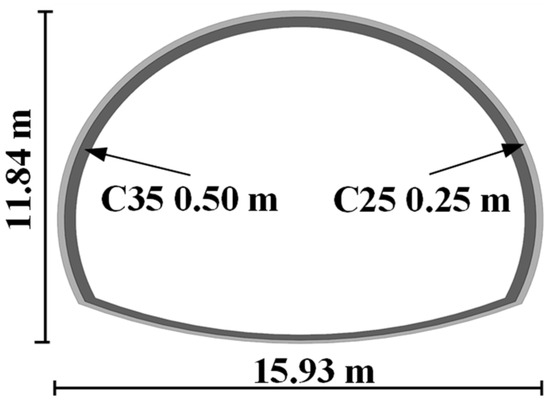
Figure 1.
Cross-section of the tunnel support system.
Geological parameters are obtained through geological investigations. The axial geological profile of the four tunnels is shown in Table 1. In the geologic profile in Table 1. The physical and mechanical parameters of the tunnel envelope are provided by the geological survey.

Table 1.
Tunnel information of Capital Ring Expressway (unit: m).
2.1.2. Monitoring Data
In this paper, the data from more than 400 monitoring sections of the Yangjiawopu Tunnel, South Fire Road Tunnel, Khan Gou 1, and Khan Gou 2 tunnels are selected. The arrangement of measurement points for the standard section is shown in Figure 2. The monitoring point A is the displacement of tunnel arch. The monitoring points B–E are the convergence deformation monitoring points. The data for tunnel arch settlement and convergence are shown in Figure 3. The deformation gradually transitions to the stabilization stage with time. The deformation prediction model targets the convergence deformation as a predictor. The distribution of deformation values for the four tunnels is shown in Figure 4. Positive values of vertical deformation represent the settlement of the vault, and positive values of convergence measurements represent smaller distances. The minimum and maximum values of settlement of the vault are 22.2 mm and 0.5 mm, respectively. The maximum and minimum values of horizontal convergence deformation of the initial support structure are 20.1 mm and 1.9 mm, respectively.
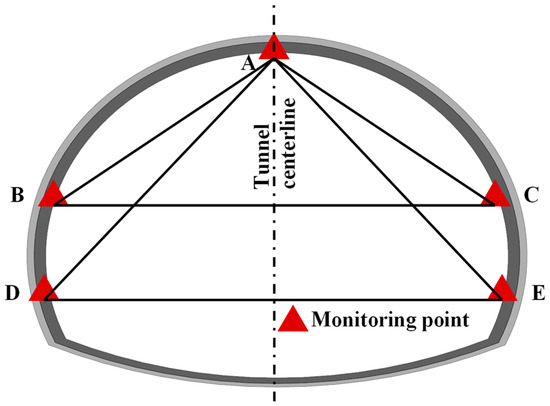
Figure 2.
Layout of monitoring points in a standard tunnel cross-section.
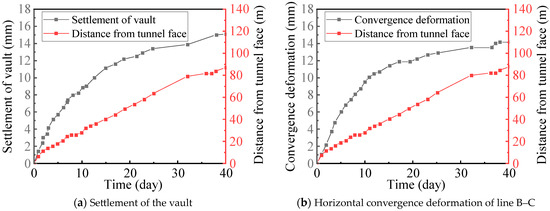
Figure 3.
Monitoring data curve over time.
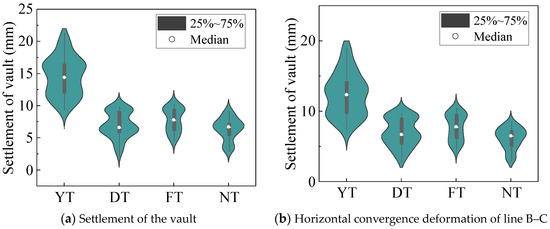
Figure 4.
Deformation distribution of initial tunnel support.
2.2. Categories of Factors Related to Primary Support Deformation
To clarify the influence factors of deformation in large-section tunnels, the influence factors of deformation are investigated from four aspects: geometric parameters, support parameters, geological parameters, and construction parameters.
2.2.1. Dataset for Deformation Prediction
Based on the influencing factors of initial tunnel support deformation proposed in Section 2.1.2, considering the distribution characteristics of the influencing factors in the axial direction of the tunnel, a data coding structure based on the longitudinal direction of the tunnel is proposed to realize the feature extraction of the information factors among the longitudinal direction of the tunnel. Considering the construction characteristics of drill and blast tunnels, some of the parameters have already been determined in the tunnel planning stage, such as geometric parameters. Due to geological uncertainties, geological information, construction information, and support information are continuously updated as the tunnel is excavated during the construction of a bored and blasted tunnel.
To facilitate data input, the tunnel is divided into n segments at fixed intervals, and the information within each segment can be categorized into four types: geometric information, geological information, support information, and construction information. Based on the order in which data of each type are generated during the construction process, a data organization and input method are proposed, as shown in Figure 5. Due to the variability of the geology, the geological information, support information, and construction information of the tunnel are continuously determined as construction progresses. The geometric parameters of the tunnel are fixed during the structural design phase of the tunnel. However, the geometric information of the tunnel is established during the construction phase. In the subsequent prediction of tunnel structural deformation, the four types of information are input within the range indicated by the blue area in Figure 5, and the ultimate deformation of the structure at the face position is used as the prediction value. After the screening of the data, 385 sets of monitoring data were used to build the database, and the ratio of training and test sets was divided according to the ratio of 8:2.
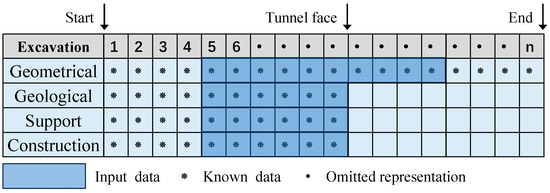
Figure 5.
Tunnel data encoding format.
2.2.2. Geometrical and Support Parameters
Tunnel geometric and support parameters have a non-negligible effect on the deformation of the tunnel’s surrounding rock and support. Excavation area, width, depth, height, and support parameters are key factors in the deformation analysis of mountain tunnels. The elastic modulus of the steel arch in the initial support and the steel reinforcement in the secondary lining were converted to concrete. The elastic modulus of initial support (Ep) and secondary lining (Es) are calculated using the following formula:
where E0 is the value of the elastic modulus of concrete. As is the value of the area of steel arch or steel reinforcement. Em is the value of the elastic modulus of steel arch or steel reinforcement. Ac is the value of the area of concrete of the support.
The geometrical and support parameters are shown in Table 2.

Table 2.
Tunnel geometry and support parameters.
2.2.3. Geological Parameters
The deformation of the initial support structure is the result of the coordinated deformation of the support and the surrounding rock. The load borne by the initial support structure is mainly influenced by the geological condition of the surrounding rock. To provide an adequate description of the geological conditions of the surrounding rock of the tunnel, the geological-related information includes rock type, surrounding rock grade, basic quality (BQ), and rock elastic wave velocity, as shown in Table 3.

Table 3.
Geological parameters of tunnel.
2.2.4. Construction Parameters
The deformation of tunnel structures is a complex process, typically divided into two crucial stages: the predeformation stage and the initial support deformation stage. Both of these stages play a vital role in tunnel engineering. In the predeformation stage, factors such as the geological conditions, groundwater levels, and the impact of existing underground structures before construction have a significant influence on the tunnel’s initial state. While some deformation during this stage may be inevitable, precise geological surveys and well-considered designs can be employed to minimize it. During the initial support deformation stage, tunnel structures are subjected to a more extensive array of influencing factors, with tunnel construction parameters being one of the primary determinants. These parameters encompass the excavation method, excavation depth, and excavation area. The selection of the excavation method can yield different responses in the tunnel structure, as distinct methods involve varying degrees of ground loosening and stress distribution. Moreover, the size of the excavation depth and the range of the excavation area directly affect the tunnel’s support requirements and the stress distribution within the support structures. In the realm of engineering construction, these parameters are of paramount importance to ensure the safety and stability of the tunnel. In tunnel construction, the method of excavation, excavation footage (Ef), and excavation area (Ea) are the parameters in engineering construction.
3. Methodology
3.1. Based Method
3.1.1. Deep Neural Network
The deep neural network (DNN) uses a fully connected network structure with a forward propagation computational algorithm. As shown in Figure 6, the DNN network model consists of an input layer, a hidden layer, and an output layer, where the number of neuron layers in the hidden layer is greater than 2.
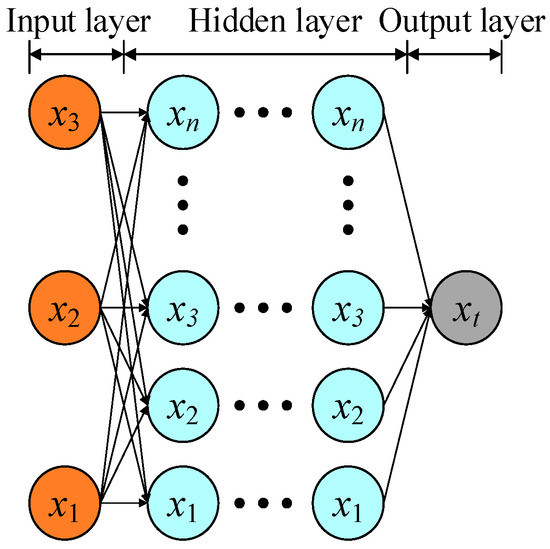
Figure 6.
DNN model composition.
The neuron consists of five components, input, weights, bias, activation function, and output, as shown in Figure 7. Commonly used activation functions in neural network models are sigmoid, tanh, relu, leaky relu, etc. Equations (2) and (3) describe the linear regression and nonlinear activation of the neuron, respectively.
where yd is the linear regression results of the j-th neuron in the l th layer. is the output and nonlinear activation result in the l-th layer. is the weight corresponding to the i-th neuron in the (l − 1)-th layer. is the bias of the j-th neuron in the l-th layer. g(·) is the activation function.

Figure 7.
Neuron in neural network.
The evaluation of the performance of neural network models is crucial. The loss function is an important part of calculating the value that represents the distance between the predicted value and the target value. If the predicted value is far from the actual value, the larger the value of the loss function will be; if the predicted value is accurate, the smaller the value of the loss function will be. The loss function determines the optimization of the parameters within the neural network model and serves to measure the overall quality of the model’s predictions. The commonly used loss functions are mean square error (MSE), mean absolute error (MAE), root mean square error (RMSE), and coefficient of determination (R2).
where mi is the value of the measurement. pi is the value of the prediction model. is the average value of the measurement. n is the total number of the dataset.
The DNN model is trained by the gradient descent method to reduce the loss function value of the model. Gradient descent training can be divided into two stages. The first stage is to find the loss function going forward. The second stage backpropagates to find the gradient of each neuron weight and bias and then updates the weights and biases according to the chain derivation law of the composite function, as shown in Equation (8).
where and are the updated weight and bias, respectively. α is the learning rate, which is one of the parameters that control the extent of parameter update. L is the loss calculated by Equations (4)–(7).
3.1.2. XGboost
Extreme Gradient Boosting (XGBoost) [33] optimizes the GBDT algorithm proposed by Friedman [34]. XGBoost does a second-order Taylor expansion of the loss function while solving for the first-order derivatives of the objective function and uses a first-order ordering of the splitting points to reduce the computational consumption, which improves the computational efficiency. The model is integrated by several trees, and the sum of the predicted value of each tree for a sample is the predicted value of the XGBoost system for that sample as a function of
where n is the total number of trees. fk(xi) is the prediction result of the k-th tree for the i-th xi. pi is the prediction result of the XGBoost system for the i-th sample.
The objective function of the XGBoost model consists of a loss function and a regularization term. The loss function is an indicator for evaluating the discrepancy between the predicted value and the true value, and the regularization term is a penalty term, the main purpose of which is to control the complexity of the model to prevent the model from overfitting.
where pi is the prediction result of the sample. mi is the true value of the sample. T is the number of leaf nodes in each tree. wj is the weight of the j-th leaf node. γ and λ are the coefficients of the model.
3.1.3. Random Forest
Random forest is an integrated learning model based on decision trees, and its modeling process is shown in Figure 8. Generate a sub-data set by random sampling from the sample data. Construct a sub-decision tree based on the sub-data set. Integrate the predictions of all sub-decision trees as the final output.
where is the prediction result of the i-th set of input vectors, i = 1, 2, 3, …, n. n is the number of input samples. F is the number of sub-decision trees. xt is the input vector of the t-th sub-decision tree. ηt is the homogeneously distributed random vector of the t-th sub-decision tree. is the output vector of the t-th sub-decision tree.

Figure 8.
Random forest framework.
The key to the random forest model lies in the random selection of features and the construction of sub-decision tree. The sub-decision tree randomly selects certain features from all the features and selects the optimal features from the randomly selected features. Sub-decision trees with different features enrich the diversity of the system and improve the prediction performance of the model.
3.2. Tunnel Primary Support Deformation Prediction Model
A new fusion deep neural network (FDNN) model based on multidimensional feature extraction is developed to predict the settlement of the vault and horizontal convergence deformation of the initial support structure. The structure of the model is shown in Figure 9. The input layer of the model consists of four parts of the data, and the features are extracted based on the physical attributes of the data, respectively. The four types of input data were selected at 0.25 times the tunnel width intervals in the axial direction of the tunnel. The data were selected within 2 times the tunnel width ahead and 3 times the tunnel width behind the predicted section to form the database. The geometrical data are selected as an array with a size of 4 × 20. The geological data, construction data, and support data are encoded as an array with a size of 8 × 12.
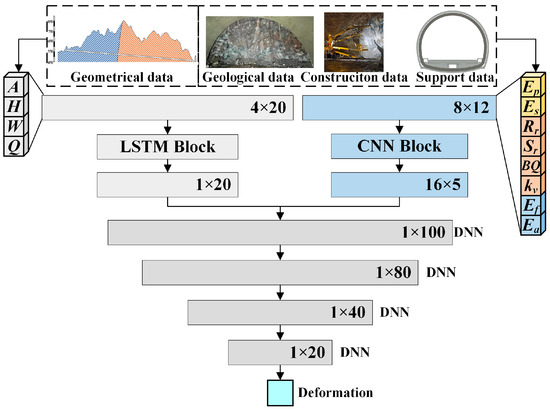
Figure 9.
Detailed flowchart of proposed FDNN model.
The deformation in the initial support phase of the tunnel is directly influenced by the geometric parameters before and after the specific cross-section. To capture this spatial influence, we employ long short-term memory (LSTM) to extract the geometric parameter information ahead and behind the prediction location. Furthermore, for geological, support, and construction data, we utilize Convolutional Neural Network (CNN) to extract distinctive features across the longitudinal span of various segments. These features, once extracted from both LSTM and CNN, are flattened and seamlessly integrated before being channeled into the deep neural network (DNN) layers. After undergoing comprehensive processing through five sequential DNN layers, the model produces a prediction for tunnel deformation. The LSTM block consists of four LSTM layers, while the CNN block comprises convolutional pooling operations. Building upon the data encoding format introduced in Section 2.2, we construct a labeled database. This database serves as the foundation for training the proposed FDNN model. As a result of this training, the LSTM and CNN blocks become adept at extracting pertinent features related to initial support deformation for each respective data type.
4. Analysis and Comparison of the Model Performance
In this section, the accuracy of the proposed method is analyzed using the dataset constructed by the project. The performance of the proposed method is compared with XGBoost, DNN, and SVM in terms of tunnel deformation prediction.
4.1. Analysis of the Prediction Model
All experiments were conducted via the toolbox Keras Sklearn or Pytorch in a computer equipped with Intel Xeon E5-2696v4 CPU at 2.20 GHz, 128 GB RAM, and NVIDIA GeForce RTX 3060Ti GPU. The change in loss functions during training is shown in Figure 10. It is evident that with an increase in the number of training iterations, the loss function gradually decreases. During the initial stages of training, the loss on the training set is lower than that on the test set. However, as the number of training iterations increases, the difference between the two gradually diminishes.
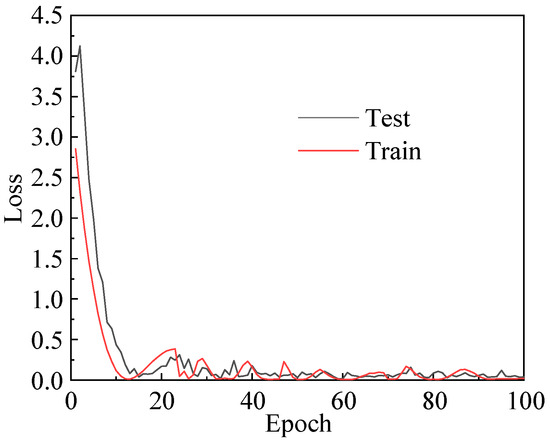
Figure 10.
Change of loss function during training process in training and test datasets.
The results of the model on the training and test sets are presented in Figure 11. The R2 values for the training and test sets are 0.927 and 0.891, respectively. The model performs better on the training set compared to the test set. The distribution of data within the deformation range does not exhibit a uniform pattern across intervals. For the same measured deformation value at a given site, the predicted results show a fluctuation range. This phenomenon may be attributed to certain construction-related factors that were not incorporated into the model training, such as face mapping information, the quality of blasting excavation, and the quality of initial support. These factors, to some extent, determine the final deformation value.
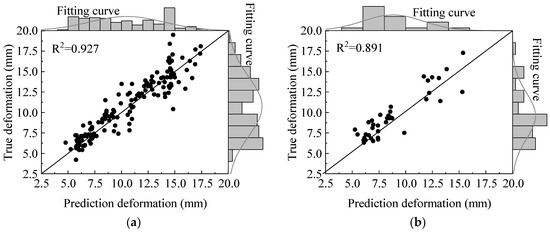
Figure 11.
Results of prediction and measurement under training and test datasets. (a) Training set. (b) Test set.
4.2. Comparative Analysis of Multi-Types Model
To evaluate the superiority of the proposed model, comparisons were made with a DNN without feature fusion. Additionally, common supervised learning methods such as XGBoost, Decision Tree Regression (DTR), and Random Forest Regression (RFR) were included in the comparative analysis. Table 4 displays the optimal key parameters or structures for these supervised learning models, which were obtained through a grid search method. The performance of the proposed method, as well as other comparative methods, is presented in Table 5. The proposed method outperforms the other methods and exhibits the best generalization. The R-squared (R2) values for the proposed model on the training set are 0.938, 0.908, 0.987, 0.991, and 0.965, respectively. On the validation set, the R2 values are 0.910, 0.821, 0.779, 0.687, and 0.768, respectively. All models perform well on the test set, but only FDNN and DNN achieve R2 values above 0.8. FDNN outperforms DNN with a 0.03 improvement in R2 on the training set and a 0.089 improvement in R2 on the test set, indicating that FDNN exhibits better generalization. Although DTR has the highest R2 on the training set, it has the lowest R2 on the test set.

Table 4.
Parameters of models.

Table 5.
Performances of models.
To demonstrate the improvement in predictive performance resulting from the inclusion of additional input parameters, the geometric parameters were used as the base parameters. Geological, support, and construction parameters were incorporated as subsequent parameters, resulting in the creation of seven different datasets with varying parameter compositions, as outlined in Table 6. MAE and R2 were selected as performance metrics for subsequent model training on these diverse datasets.

Table 6.
Dataset for models.
The MAE values for all models under different inputs are shown in Figure 12. In the subsequent analysis, geometric parameters were used as the foundational parameters. The performance improvement resulting from DS1–DS3 indicates that geological parameters have the most significant impact on model performance across all models. For DS4–DS6, the combination of geological and construction parameters in the database yields favorable performance improvements for all models. FDNN, DNN, and XGBoost models consistently outperform DRT and RFR models in both training and testing phases on DS1–DS7 datasets. The model performance ranking, from highest to lowest, is as follows: FDNN, DNN, XGBoost, RFR, and DRT. The proposed FDNN model exhibits the best performance across datasets with different parameter combinations, showcasing its robustness and superior performance.
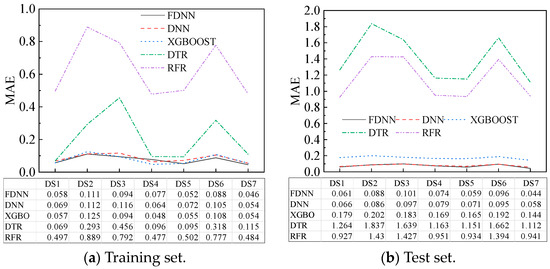
Figure 12.
MAE of all models under different datasets.
The R2 values for all models under different inputs are shown in Figure 13. All models exhibit consistent performance in both training and testing processes across DS1-DS7 databases. For FDNN, DNN, and XGBoost models, the impact of different data types on model performance improvement varies. The training results of the database consisting of three types of data did not significantly outperform the database consisting of two types of data. Increasing the data types rather reduces the model performance, such as in DS4 and DS1. Performance across all models is superior in the DS7 dataset compared to other datasets, indicating that the fusion of multiple datasets synergistically enhances model predictive performance. That is because incomplete information can create conflicts that reduce the effectiveness of the model. Richer information will neutralize the conflicts and convert them into model performance boosts. In engineering scenarios, various data types often contain overlapping information due to the influence of human factors. Therefore, the improvement in model training effectiveness through the combination of multiple data sources into a single database is not a simple additive effect.

Figure 13.
R2 of all models under different datasets.
5. Conclusions
In this work, an FDNN model is proposed to predict the deformation of the initial support. It employed a feature extraction and fusion method that integrates various tunnel parameters to enhance the performance. The influence of tunnel parameters on the performance is analyzed. The main findings are summarized as follows:
- (1)
- Compared to the DNN, XGBoost, DT, and RTR models, the FDNN model demonstrates better predictive performance in terms of deformation prediction. The fusion of various data enhances the model’s robustness;
- (2)
- The training data composition had a large impact on the results. The degree of data influence is in the order of geological data, support data, and construction data;
- (3)
- The performance of the model gradually rises with the increase in data types. Different tunnel feature data overlap and are superpositioned for model performance enhancement.
The construction machine operation information and geologic forecast information were not considered in the model in this study, and the machine operation parameters and geologic forecast data contain rich geologic information, which can be considered in the model in future studies.
Author Contributions
Conceptualization, J.Z. and M.M.; methodology, Q.F. and J.W.; software, X.H. and G.S.; formal analysis J.Y.; writing—original draft preparation, Q.F. and J.W. All authors have read and agreed to the published version of the manuscript.
Funding
This research was funded by Key Project of High-speed Rail Joint Fund of National Natural Science Foundation of China (U1934210) and Natural Science Foundation of Beijing (8202037).
Institutional Review Board Statement
Not applicable.
Informed Consent Statement
Not applicable.
Data Availability Statement
The data presented in this study are available on request from the corresponding author. The data are not publicly available due to privacy.
Conflicts of Interest
Author Junling Zhang and Min Mei are employed by the Road & Bridge International Co., Ltd. Author Guangpeng Shang and Xuefeng Hu are employed by the Beijing & Hebei Construction and Development Co., Ltd. The remaining authors declare that the research was conducted in the absence of any commercial or financial relationships that could be construed as a potential conflict of interest.
References
- Wang, M.S. An overview of development of railways, tunnels and underground works in China. Tunn. Constr. 2010, 30, 351. [Google Scholar]
- Haruyama, K.; Teramoto, S.; Taira, K. Construction of large cross-section double-tier Metropolitan Inter-city Highway (Ken-O-Do) Ome Tunnel by NATM. Tunn. Undergr. Space Technol. 2005, 20, 111–119. [Google Scholar] [CrossRef]
- Hong, Q.Y.; Lai, H.P.; Liu, Y.Y.; Ma, X.M.; Xie, J.T. Deformation control method of a large cross-section tunnel overlaid by a soft-plastic loess layer: A case study. Bull. Eng. Geol. Environ. 2021, 80, 4717–4730. [Google Scholar] [CrossRef]
- Sun, Z.Y.; Zhang, D.L.; Li, A.; Lu, S.; Tai, Q.M.; Chu, Z.F. Model test and numerical analysis for the face failure mechanism of large cross-section tunnels under different ground conditions. Tunn. Undergr. Space Technol. 2022, 130, 104735. [Google Scholar] [CrossRef]
- Zhao, S.G.; Wang, M.N.; Yi, W.H.; Yang, D.; Tong, J.J. Intelligent classification of surrounding rock of tunnel based on 10 machine learning algorithms. Appl. Sci. 2022, 12, 2656. [Google Scholar] [CrossRef]
- Focaracci, A.; Greco, G.; Martirano, L. Smart tunnel and dynamic risk analysis. IEEE Trans. Ind. Appl. 2020, 56, 2338–2347. [Google Scholar] [CrossRef]
- Yang, H.; He, X.H.; Xu, X.Y.; Wei, X.J.; Wang, Y.W. Laser-based intelligent perception method for tunnel invasion. Mech. Adv. Mater. Struct. 2022, 29, 6451–6458. [Google Scholar] [CrossRef]
- Li, X.; Jia, C.; Zhu, X.; Zhao, H.L.; Gao, J. Investigation on the deformation mechanism of the full-section tunnel excavation in the complex geological environment based on the PSO-BP neural network. Environ. Earth Sci. 2023, 82, 326. [Google Scholar] [CrossRef]
- Mezger, F.; Anagnostou, G.; Ziegler, H.J. The excavation-induced convergences in the Sedrun section of the Gotthard Base Tunnel. Tunn. Undergr. Space Technol. 2013, 38, 447–463. [Google Scholar] [CrossRef]
- Bian, K.; Liu, J.; Liu, Z.P.; Liu, S.G.; Ai, F.; Zheng, X.Q.; Ni, S.H.; Zhang, W. Mechanisms of large deformation in soft rock tunnels: A case study of Huangjiazhai Tunnel. Bull. Eng. Geol. Environ. 2019, 78, 431–444. [Google Scholar] [CrossRef]
- Zhou, H.; Qu, C.K.; Hu, D.W.; Zhang, C.Q.; Muhammad, U.A.; Shen, Z.; Chen, J. In situ monitoring of tunnel deformation evolutions from auxiliary tunnel in deep mine. Eng. Geol. 2017, 221, 10–15. [Google Scholar] [CrossRef]
- Luo, Y.B.; Chen, J.X.; Wang, H.Y.; Sun, P.L. Deformation rule and mechanical characteristics of temporary support in soil tunnel constructed by sequential excavation method. KSCE J. Civ. Eng. 2016, 21, 2439–2449. [Google Scholar] [CrossRef]
- Fang, Q.; Su, W.; Zhang, D.L.; Yu, F.C. Tunnel deformation characteristics based on on-site monitoring data. Chin. J. Rock Mech. Eng. 2016, (In Chinese). [Google Scholar]
- Xue, Y.G.; Ma, X.M.; Qiu, D.H.; Yang, W.M.; Qu, C.Q. Analysis of the factors influencing the nonuniform deformation and a deformation prediction model of soft rock tunnels by data mining. Tunn. Undergr. Space Technol. 2021, 109, 103769. [Google Scholar] [CrossRef]
- Hoek, E.; Marinos, P. Predicting tunnel squeezing problems in weak heterogeneous rock masses. Tunn. Tunn. Int. 2000, 32, 45–51. [Google Scholar]
- Wang, G.; Fang, Q.; Du, J.; Yang, X.; Wang, J. Estimating Volume Loss for Shield-Driven Tunnels Based on the Principle of Minimum Total Potential Energy. Appl. Sci. 2022, 12, 1794. [Google Scholar] [CrossRef]
- Wang, G.; Fang, Q.; Du, J.M.; Wang, J.; Li, Q.M. Deep learning-based prediction of steady surface settlement due to shield tunnelling. Autom. Constr. 2023, 154, 105006. [Google Scholar] [CrossRef]
- Pellet, F.; Roosefid, M.; Deleruyelle, F. On the 3D numerical modelling of the time-dependent development of the damage zone around underground galleries during and after excavation. Tunn. Undergr. Space Technol. 2009, 24, 665–674. [Google Scholar] [CrossRef]
- Guan, K.; Zhu, W.C.; Wei, J.; Liu, X.G.; Niu, L.L.; Wang, X.R. A finite strain numerical procedure for a circular tunnel in strain-softening rock mass with large deformation. Int. J. Rock Mech. Min. Sci. 2018, 112, 266–280. [Google Scholar] [CrossRef]
- Fang, Q.; Wang, J.; Wang, G.; Li, Q.Q.; Ma, W.B. Intelligent back analysis using clonal selection algorithm in calculating equivalent top loading curve using O-cell test data. J. Cent. South Univ. 2023, 30, 3481–3498. [Google Scholar] [CrossRef]
- Ring, B.; Comulada, M. Practical numerical simulation of the effect of TBM process pressures on soil displacements through 3D shift iteration. Undergr. Space 2018, 3, 297–309. [Google Scholar] [CrossRef]
- Ninić, J.; Koch, C.; Vonthron, A.; Tizani, W.; König, M. Integrated parametric multi-level information and numerical modelling of mechanised tunnelling projects. Adv. Eng. Inform. 2020, 43, 101011. [Google Scholar] [CrossRef]
- Zhou, J.; Yang, X.N.; Guo, J. Stability predictions for excavations of mountain tunnels based on [BQ] method and its field verification. Eng. Fail. Anal. 2022, 141, 106727. [Google Scholar] [CrossRef]
- Sun, J.L.; Wu, S.C.; Wang, H.; Wang, T.; Geng, X.J.; Zhang, Y.J. Inversion of Surrounding Rock Mechanical Parameters in a Soft Rock Tunnel Based on a Hybrid Model EO-LightGBM. Rock Mech Rock Eng. 2023, 56, 6691–6707. [Google Scholar] [CrossRef]
- Bourquin, J.; Schmidli, H.; Van, H.P.; Leuenberger, H. Application of artificial neural networks (ANN) in the development of solid dosage forms. Pharm. Dev. Technol. 1997, 2, 111–121. [Google Scholar] [CrossRef] [PubMed]
- Szelag, B.; Studziński, J. A Data Mining Approach to the Prediction of Food-to-Mass Ratio and Mixed Liquor Suspended Solids. Pol. J. Environ. Stud. 2017, 26, 2231–2238. [Google Scholar] [CrossRef]
- Kim, C.Y.; Bae, G.J.; Hong, S.W.; Park, C.H.; Moon, H.K.; Shin, H.S. Neural network based prediction of ground surface settlements due to tunnelling. Comput. Geotech. 2001, 28, 517–547. [Google Scholar] [CrossRef]
- Ocak, I.; Seker, S.E. Calculation of surface settlements caused by EPBM tunneling using artificial neural network, SVM, and Gaussian processes. Environ. Earth Sci. 2013, 70, 1263–1276. [Google Scholar] [CrossRef]
- Eberhart, R.C.; Kennedy, J. A New Optimizer Using Particle Swarm Theory. In Proceedings of the Proceedings of the Sixth International Symposium on Micro Machine and Human Science (MHS ’95), Nagoya, Japan, 4–6 October 1995; pp. 39–43. [Google Scholar]
- Pan, W.T. A new Fruit Fly Optimization Algorithm: Taking the financial distress model as an example. Knowl.-Based Syst. 2012, 26, 69–74. [Google Scholar] [CrossRef]
- Mirjalili, S.; Mirjalili, S.M.; Lewis, A. Grey Wolf Optimizer. Adv. Eng. Softw. 2014, 69, 46–61. [Google Scholar] [CrossRef]
- Mirjalili, S.; Lewis, A. The Whale Optimization Algorithm. Adv. Eng. Softw. 2016, 95, 51–67. [Google Scholar] [CrossRef]
- Chen, T.Q.; Guestrin, C. XGBoost: A Scalable Tree Boosting System. In Proceedings of the ACM SIGKDD International Conference on Knowledge Discovery and Data Mining, San Francisco, CA, USA, 13–17 August 2016. [Google Scholar]
- Friedman, J.H. Greedy Function Approximation: A Gradient Boosting Machine. Ann. Stat. 2001, 29, 1189–1232. [Google Scholar] [CrossRef]
Disclaimer/Publisher’s Note: The statements, opinions and data contained in all publications are solely those of the individual author(s) and contributor(s) and not of MDPI and/or the editor(s). MDPI and/or the editor(s) disclaim responsibility for any injury to people or property resulting from any ideas, methods, instructions or products referred to in the content. |
© 2024 by the authors. Licensee MDPI, Basel, Switzerland. This article is an open access article distributed under the terms and conditions of the Creative Commons Attribution (CC BY) license (https://creativecommons.org/licenses/by/4.0/).






